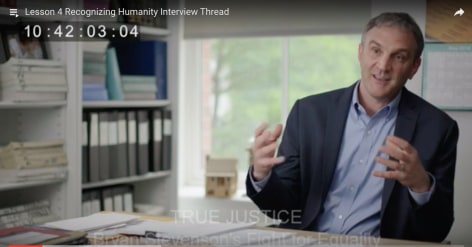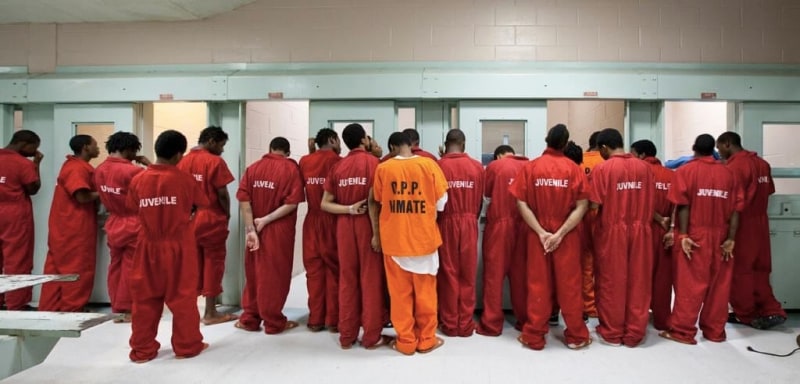
Featuring Randy Susskind and Sia Sanneh

RichardRoss.net
Essential Question: How does the Equal Justice Initiative (EJI) work strategically to end the harsh punishment of children in the criminal justice system?
In this two-day lesson, students will examine how the Equal Justice Initiative evolved from an organization that was primarily focused on legal advocacy into one that also addresses the way our nation thinks about and teaches our history, and what it will take to bring about racial and economic justice.
To deepen their understanding of this lesson’s essential question, students will engage in a case study that illustrates EJI’s dual approach to fighting for justice for children in our system of mass incarceration. Using multiple source materials including documentary film clips from True Justice: Bryan Stevenson’s Fight for Equality, first-person interviews collected during the making of the documentary and excerpted from the Interview Archive, and audio recordings of oral arguments from the United States Supreme Court, students will immerse themselves in how EJI’s legal and education efforts work in tandem to create change. Students will synthesize their learning of EJI’s strategic approach to reform and justice on the narrative map of their choice.
Students will:
* Examine EJI’s work to end unfair and harsh punishment for children in prison
* Conduct research on Supreme Court Cases that directly challenge the treatment and sentencing of juveniles in the criminal justice system
* View segments from True Justice and the Interview Archive to deepen understanding about the strategies EJI uses to achieve these goals
* Use the source materials from the lesson to summarize their understanding of EJI’s approach to transforming law, education, and culture simultaneously
Materials: Equipment for viewing film clips and interview threads, and copies of all handouts
Length: Two 50-minute class periods plus homework
1. Introducing the Work of EJI through True Justice
Teacher Note: While these opening film clips do not directly focus on the work of EJI with children, they do build background knowledge on the work of EJI and how it has evolved over time.
Distribute Handout 1: The Work of EJI Note Catcher (linked in "Resources" section below)
Ask students to review the Note Catcher before watching the clips so they are familiar with the questions. Invite students to write down their notes while watching, and offer a few minutes after each clip to complete their notes.
Watch Film Clips One and Two (in the Film Clips section below)
Clip One: "You’ve Got to Be Brave, Brave, Brave" (runtime 5 min)
In this clip, Bryan Stevenson recounts the story of meeting Ms. Johnnie Carr and Ms. Rosa Parks after moving to Montgomery, Alabama in the 1980s and the inspiration and strength he gained from these women’s lifetime of activism and commitment to fighting for racial equity.
Clip Two: "I Am Part of the Broken Community" (runtime 6 min)
In this clip, Randy Susskind and Bryan Stevenson reflect upon the professional and personal challenges of working with death penalty cases. Bryan also reflects on how he garners strength from struggle and is inspired by the struggles of other civil rights leaders in history such as Dr. Martin Luther King.
Debrief Clips One and Two with these recommended questions:
* What new information did you learn about the work of EJI to add to your understanding?
* In your own words, how would you explain the difference between law and justice? (For classes that completed Lesson Three), How do these clips change or enhance your understanding of the difference between law and justice?
Watch Clip Three: "All Children Change" (run time ~7 min)
The clip begins with Bryan Stevenson sharing a very personal story about the murder of his grandfather and how this crime is deeply rooted to his understanding of racial injustice in the United States, particularly regarding African American youth, and how this has informed his work with children within the Equal Justice Initiative
After watching, offer students a moment to finish collecting what they learned and writing down any questions that remain on the Note Catcher.
Share All Children Are Children with students by projecting each page and taking time to read the information and absorb the powerful photographs from Richard Ross. Invite students to pay close attention to the images and jot down ideas and statistics from the report that demonstrate why children are considered fundamentally different than adults and should be treated differently within the legal system.
Before leaving class, have students complete an Exit Ticket using the prompt: “What connections do you see between the legal, educational, and cultural work of EJI?” Collect the Exit Tickets and assess for student understanding. If there are gaps or lingering questions, consider incorporating these into the Opening exercise of Day Two.
Begin day two by having students review their notes and handouts from the previous day, and ask one or two students to share their impressions thus far.
Watch EJI Video - "Cruel and Unusual: Sentencing 13 and 14 year olds to die in prison" video (runtime 3:30 min). This EJI-produced piece details EJI’s work with children and the particular laws imposing life without parole on children.
Teacher Note: Students will listen to recordings of the oral arguments Bryan Stevenson made in front of the Supreme Court in either of the cases pertaining to the imposition of life without parole on juveniles for non-homicide offenses.
Distribute Handout Two - The Supreme Court and EJI’s Work with Children
Read over the list of cases in Handout Two and explain to students that they will be listening to the oral arguments in one of the two cases that challenge the imposition of life without parole sentences on juveniles, Sullivan v. Florida or Miller v. Alabama.
Have students listen to Bryan Stevenson's opening arguments for either Sullivan v. Florida or Miller v. Alabama, on oyez.org. More details for each in Handout Two. Because his portion of the opening argument runs 25:00 minutes, adjust the listening time to the pace of your class, with 15 minutes being the minimum recommended time for students to listen and get a sense of presenting an oral argument in front of the Supreme Court.
If internet access is available in class, students can follow along the written transcript of the oral argument that is on oyez.com with the audio. If internet is not available, print or project the transcripts for students to follow along.
A Close View - Interview Threads
Teacher Note: The film makers conducted numerous interviews to produce True Justice and nine of these interviews are free and accessible in the Interview Archive on this website. A selection of these interviews, edited together here to create interview threads, are available for your students’ learning.
Two interview threads were created for this lesson that teachers and students can choose from, or use together, to deepen their understanding of the lesson topic.
Print and distribute Handouts 3 and 4 in the "Resources" section in the lesson so students can follow along with the interview transcripts.
Handout 3: "Recognizing Humanity" Thread, Interview Archive
Handout 4: "All Children are Children" Thread, Interview Archive
Watch the Interview Threads, and have students follow along on the transcripts, under-lining details that catch their attention, and jotting down questions and insights that come to mind after viewing each thread.
Closing Discussion Questions
* What are some areas of advocacy that can be used to shift inequalities in the criminal justice system?
* If you could communicate one thing you've learned so far about the criminal justice system to all high schools around the United States, what would it be?
* Discuss your understanding of how EJI’s strategy evolved from a legal advocacy organization to include educational work.
* How does understanding the narrative of racial difference and gaining deeper insight into our nation’s history of racial inequality support EJI’s legal arguments?
Extended Learning
Option One: Visual Representations of Informaion
Have students work in pairs to turn a relevant quote and/or statistic into a concrete visual representation such as an infographic or illustration. Students can use data from the film, or conduct individual research to expand on their chosen quote or statistic. For example, students can find a statistic online about the Death Penalty and exonerations and visually represent it for the class.
Option Two: Examining the History of Life Without Parole
Research the history of life without parole sentences in the United States and write an essay about what you learned about death in prison sentences. Here are several organizations with resources to access:
The Marshall Project: “Life Without Parole”
Death Penalty Information Center “Life Without Parole”
The Sentencing Project “Criminal Justice Facts”
ACLU “A Living Death: Life without Parole”
The New Yorker "The Meaning of Life Without Parole"
Bryan Stevenson and the Equal Justice Initiative believe that throughout history, false narratives have helped to create and sustain injustice, and that it is necessary to confront and change these narratives in order to create a more just society.
To engage students in the process of building a new narrative, each lesson culminates by having students synthesize their learning and map out this information into a form of their choosing. In Lesson Six students will compile these new narrative maps to complete a final assessment.
Distribute Handout Five
Using the narrative map of your choice, organize your learning to reflect your impressions, insights, opinions, and questions about the essential question of this lesson, how EJI works strategically to end the harsh punishment of children in the criminal justice system.
Here are some suggested models of narrative maps:
* Storyboard - A sequence of drawings, typically with some directions and dialogue - that conveys their understanding of the lesson topic.
* Graphic Organizer - A relational way to present information in both a visual and text format
* Sketchnotes - Often referred to as doodling, sketchnoting is defined as creative, individualized note taking that uses a mix of words and pictures together to create a personal story or narrative
Reading Literature and/or Information: Integration of Knowledge and Ideas.
RL/RI.X.7. Integrate and evaluate content presented in diverse media and formats, including visually and quantitatively, as well as in words.
RL/RI.X.8. Delineate and evaluate the argument and specific claims in a text, including the validity of the reasoning as well as the relevance and sufficiency of the evidence.
RL/RI.X.9. Analyze how two or more texts address similar themes or topics in order to build knowledge or to compare the approaches the authors take.
Speaking and Listening: Comprehension and Collaboration
SL.X.1 Prepare for and participate effectively in a range of conversations and collaborations with diverse partners, building on others’ ideas and expressing their own clearly and persuasively.
SL.X.2. Integrate and evaluate information presented in diverse media and formats, including visually, quantitatively, and orally
SL.X.3 Evaluate a speaker’s point of view, reasoning, and use of evidence and rhetoric.
SL.X.5 Make strategic use of digital media and visual displays of data to express information and enhance understanding of presentations.
Writing: Research to Build and Present Knowledge
W.X.7: Conduct short as well as more sustained research projects based on focused questions, demonstrating understanding of the subject under investigation.
W.X.8 Gather relevant information from multiple print and digital sources, assess the credibility and accuracy of each source, and integrate the information while avoiding plagiarism.
